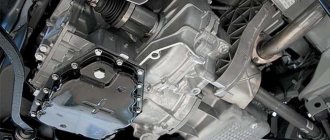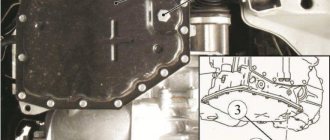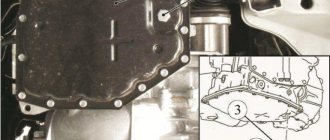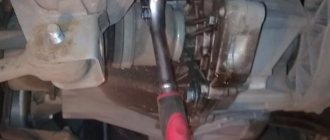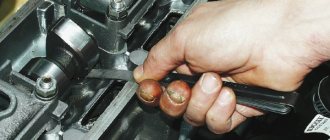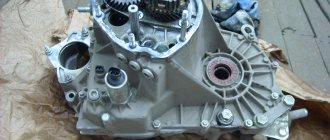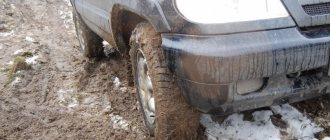As is the case with a car engine, the oil in the Lada Granta automatic transmission needs to be regularly checked, updated and completely replaced if necessary. To avoid having to perform expensive transmission repairs, motorists need to know how to check, what to look for, and how to change the oil in an automatic transmission themselves.
Replacement
- We place a suitable container under the box and wipe the surface around the perimeter of the drain hole.
- Unscrew the nut (plug). The oil flow is not as intense compared to “mechanics”. Therefore, it is necessary to unscrew another nut located at the top of the unit.
Some owners of Lada Granta resort to the procedure of washing the box. To do this, use kerosene or diesel fuel. Due to the intense saturation of the oil with particles, even a small portion of it remaining in the unit can saturate the “new” lubricant with an unwanted “metallic additive”.
Consequences of overflow
This phenomenon can have a very negative impact on the gearbox. When oil is in excess, it tends to foam. This condition leads to a loss of lubricating properties, since air begins to “lubricate” the part instead of oil. The result is failure of the automatic transmission, since the parts begin to burn without receiving adequate lubrication. In addition, foaming causes transmission fluid to leak through the breather.
You can check the condition of the box by carefully inspecting the oil fluid. If the automatic transmission is not damaged and operates normally, the lubricant is red in color, the liquid does not contain any dark-colored foreign particles, such as solid particles. If the ATF is dark in color and smells burnt, the automatic transmission is destroyed. The solid particles that can be seen on the dipstick are the result of the destruction of the clutches and brake band.
Sequence of oil change steps
Changing the oil in the Lada Granta automatic transmission on a regular basis will help extend the life of the automatic transmission.
In addition, the condition of the drained oil in the Lada Granta automatic transmission will signal the presence of some problems, the accounting of which may require additional inspection or repair of the corresponding components.
Indicative signs of problems are shown in the table:
| Color of drained fluid | Possible problem |
| Dark or black, with a burning smell | Wear of friction elements |
| Milky pink | Penetration of water from outside through the filling tube or breather |
| Sticky, light to dark brown in color | Oxidation - overfilling or underfilling of liquid. Overheat. |
Changing the oil in the Lada Granta automatic transmission involves removing the oil pan and the oil filter cover, followed by replacing it or thoroughly washing it.
To change the oil in the automatic transmission of a 16-valve Lada Granta, you will need the following tools and consumables:
- keys (heads) at “10”, “19” and an L-shaped hexagon at “5”;
- hose with funnel;
- lint-free rags, hard brush;
- container for draining used oil;
- inspection hole, overpass or lift;
- anti-recoil shoes.
Changing the oil in the automatic transmission of a 16 valve Lada Granta
To drain the oil, the following preparatory procedures must be carried out:
- Start the engine and let the gearbox warm up until the fluid reaches operating temperature (HOT mark on the dipstick at a temperature of 50 °C to 80 °C).
- Turn off the engine.
- Remove the air filter (not completely, just to make room for access to the dipstick for checking the fluid level in the automatic transmission).
The last step is to move under the car and remove the engine crankcase protection for easy access to the box pan.
Draining waste fluid
To drain the transmission fluid, do the following:
- Using a key set to “19”, unscrew the plug on the transmission pan.
- Carefully pour the used oil into the prepared container (please note that this is only a part that should be taken into account when calculating the amount of fresh transmission fluid to be subsequently poured).
- Place the long end of the L-shaped hexagon at “5” into the hole from the unscrewed plug and, aligning it with the socket of the overflow tube, carefully unscrew it and rinse it.
- After waiting for the oil to stop leaking from the drain hole, proceed to remove the pan, which is secured to the box with 16 identical bolts through a gasket, which is recommended to be replaced during reassembly.
- Using a “10” head, unscrew 16 identical mounting bolts of the pan (it is better to unscrew the bolts around the perimeter first, and the corner bolts last, to avoid a sudden release of the hot oil contained in it due to sagging of the pan).
- Having removed the pan, proceed to unscrew the 12 bolts of the oil filter cover (the bolts are of different lengths, so it is important to mark their location around the perimeter so as not to damage the mechanics during reassembly). It should be borne in mind that there is also a certain amount of transmission fluid in the filter cover, which must be taken into account when calculating the required volume.
The removed pan and cover are thoroughly cleaned, and the filter is replaced.
Washing the tray and removing chips
At the bottom of the pan there are 2 magnets that hold metal particles that enter the transmission fluid as a result of running-in and partial wear of the friction elements of the mechanism.
"Lada Granta": changing the oil in the automatic transmission
They need to be completely cleaned in the same way as the pan itself, using suitable rags and gasoline.
Replacing the automatic transmission filter
In Lada Granta cars, changing the oil in the automatic transmission is accompanied by installing a new filter. Sometimes you can leave the old one by rinsing the mesh well in gasoline and removing the metal filings. This will ensure correct operation of the oil pump.
Adding fresh oil
Having installed the parts removed and cleaned of old oil and metal filings in the reverse order (observing the correspondence of the bolts and their seats in the filter cover), they begin to fill fresh transmission fluid through the oil receiver, which also serves as a tunnel for the dipstick, in a volume equal to that drained.
Very important : the amount of liquid poured must exactly match the drained volume. The automatic transmission manufacturer warns against exceeding its level.
After filling, start the engine and check all connections for leaks from under the crankcase cover fastenings. With the engine idling, holding down the brake pedal, move through all positions of the driving mode selection lever. And finally, having stopped in position “P”, they begin to check the fluid level with the power unit idling:
How to wash the unit?
The procedure includes the following steps:
- unscrew the drain plug;
- fill the “automatic machine” with a flushing agent;
- we start the engine and perform periodic switching with the selector in all modes;
- turn it off and, unscrewing the drain plug, drain the resulting “premix”.
The procedure is repeated at least three times.
We continue to replace
- We are waiting for the complete flow of mining.
- We wait the few minutes necessary for the internal cavity of the transmission to dry.
- Fill in new fluid. The principle is similar to the action with “mechanics”.
- We control the level.
- We start the engine and give it the opportunity to function without increased loads.
- We check the level again, and if it corresponds to the norm, we consider the procedure completed.
Design features of the Jatco automatic transmission
Lada Granta cars are equipped with a four-speed automatic transmission Jatco JF414 (AY-K3). The characteristics of the new car are as close as possible to international standards. The Lada Granta gearbox is equipped with a reliable hydraulic unit.
The technical capabilities and operational properties of this automatic transmission are excellent for modern domestically produced cars. The gearbox is protected from overheating; reliable protection is triggered when it reaches +114°C. Sensor readings below this parameter are considered normal for further movement. The Grant gearbox is controlled using an electronic control unit (ECU).
Engine (Rosneft 5W-30)
From the factory, the engine of the Lada Granta car is filled with Rosneft semi-synthetic oil 5W-30 . There is no such oil on the market, since it contains special additives that serve for better running-in of the new engine.
8 valve
8-valve engine (87 hp)
On an 8-valve engine, zero maintenance must be done at 2,500 km , since the valves need to be adjusted there. It is at this mileage that the oil is changed to a new one, and the old, break-in oil is drained.
16 valve
16 valve engine (98 hp)
And on a 16-valve engine, zero maintenance is carried out only at a mileage of 15,000 km, so some owners themselves change the oil at a mileage of up to 5,000 km . But there is no definite answer here, since car enthusiasts have different opinions.
List of replacements
List of recommended engine oils for the engine
Video about choosing oil (engines are similar)
How to choose your own motor oil?
What kind of oil is in Lada Granta automatic
Changing the oil in an automatic transmission on a Grant
The requirements for the quality, composition and quantity of lubricant are very high. Oil life is highly dependent on operating conditions and can vary from 30,000 miles (50 thousand km) to 120,000 miles (200 thousand km).
If there is an increased load on the transmission (driving on bad roads, a fully loaded car, constant driving with a roof rack), it is necessary to regularly check the oil in the Granta automatic transmission to see if it needs partial or complete replacement. Information about what kind of oil can be filled into the Lada Granta automatic transmission is provided by the manufacturer.
Original oils
The manufacturer of the Jatco JF414E gearbox, Jatco, recommends using only Nissan ATF Matic-S 999MP-MTS00P transmission fluid of its own production for operation in the unit. It's quite expensive.
Lubricant analogues
There are alternative options for transmission fluids that are similar in parameters to those recommended by the developer. Therefore, changing the oil in an automatic transmission on a Grant can be done using an analogue that corresponds to the Matic-S classification, such as, for example, the following oils:
- Castrol Full Synthetic ATF;
- Castrol Transmax™ DEXRON®-VI Automatic Transmission Fluid;
- Valvoline MaxLife Multivehicle Synthetic ATF.
Oil in automatic transmission Lada Granta
All of them, including Nissan ATF Matic-S 999MP-MTS00P, are the same substance for working in automatic transmissions, but under different brands.
Manual transmission (Tatneft TM-4-12 SAE 75w-85 GL-4)
From the factory, the gearbox on the Lada Granta (both existing modifications) is filled with Tatneft TM-4-12 SAE 75w-85 GL-4 (TATNEFT TRANSLUX TM4-12). If there are no TatNeft gas stations in your region, then most likely you will have difficulty finding this oil.
The manufacturer answers all questions via the AvtoVAZ hotline that the service life of this oil is 150,000 km , and it should only be changed to the recommended ones.
Since the issue of choosing oil in a manual transmission is a separate large topic in which there are active discussions, we will only briefly describe alternative replacements.
When should you change it?
We still recommend changing the gearbox oil at a mileage of no earlier than 15,000 km. During this time, the old oil will break in, and all the “break-in slag” will come out with it.
Theory - watch the video!
4-speed transverse automatic transmission of the “mini” class for front-wheel drive - JF414 developed by the Japanese Jatco for cars with engines up to 1.6 liters.
It was the JF414 automatic that AvtoVAZ chose to install on the Lada Granta.
In addition to the Lada Granta, the JF414E has been installed on Nissan Almerias and Marches with engines up to 1.6 liters since 2013. In addition, it can be found on our rare Ad Van. This transmission is designed as a budget and reliable option for “long-lasting” cars. Competitor - Aisin AW60-40. Jatko classification means - JF414: J - Jatco, F - (Forward) front-wheel drive, 4 - number of stages, 14 - serial number of modification. E - electronic shift control.
More details about the machine
When choosing an automatic machine for the Grant, Tolyatti engineers faced the following conditions: - the box had to fit into the engine compartment of the Lada and, of course, had to be very simple and very reliable.
Another contender for the Lada hood can be considered practically the only competitor: Aisinovsky AW60-40. But Aisin Warner is considered uncompromising on prices and feels confident enough in the market to give special discounts to VAZ. Therefore, the JF414 variant from Ott Jatko turned out to be more interesting.
There were, of course, hypothetical versions of American boxes, such as 4F27E, but they were completely uncompetitive in many respects, including political ones.
Among the German boxes for Lada, ZF 4HP14 would be suitable. But the German gearbox, while highly reliable, is quite expensive, and ZF itself is not very active in the market for mini and micro class machines. Therefore, the marriage of Granta and Jatko seems a completely natural choice.
The only drawback of the Jatkov box is the narrow market for this class of machines. With the advent of CVTs, fewer and fewer manufacturers are installing reliable but expensive gearboxes on micro- and mini-class cars, and are increasingly choosing a cheaper and less resourceful CVT. In addition to VAZ, this box was installed on Nissan March for some time, but soon they switched to CVTs, leaving VAZ as the only consumer of this machine.
The JF414E uses all the latest electronics to control the valve body and torque converter, including linear (PWM) electric control solenoids to control the shift hydraulics with minimal power disruption.
In general, the JF414 gearbox was designed by Jatko according to VAZ’s technical specifications in order to be “indestructible” and outlast the car itself. A typical case of reinsurance, when a viral myth about the “fragility of the machine” is widespread among buyers.
The next generations of automatic transmissions for this class of car will have a choice between used Dzhatkov CVTs and European DSGs with a dry clutch (AMT), which are cheaper and live a brighter (for acceleration and fines), but short life.
Changing the oil and filter
The first machine maintenance is an oil change.
Although the oil is considered non-replaceable, (about burning oil) with frequent overloads of the machine, the oil soon becomes dirty and opaque and requires replacement.
JF414 itself is very unpretentious to oil and allows the use of not only the original Matic-S (EJ-1 ATF), but also non-original analogues such as Dexron VI. Although automatic transmission electricians say that the settings of the JF414 solenoids and valves are sensitive to the type of oil. The oil is checked (for quality and quantity) with a dipstick at operating temperature and topped up through the same hole. Some technicians check the oil level and quality using the overflow tube by unscrewing the pan plug. The oil is changed through several partial changes. An oil change should be done with the help of specialists who have experience in automatic transmission repair or who have studied the oil change process in detail. It has its own important features.
Filter JF414 - metal open with metal mesh - 327010. Our technicians rarely change such a filter during the first oil change; washing and cleaning the filter solves the main problems. The oil is changed first after 80-100 tkm of mileage, depending on the loads during operation and, as a result, on the degree of contamination of the oil, but usually by this time the oil still retains “working” transparency.
Masters install on older cars with worn iron in series with the coarse filter - external fine filter - 100019. The main filter fits into the cooling hose from the outside of the box and access to it for inspection and replacement can be made as easy as possible.
The main magnetic filter helps keep the oil clean and slows down wear on components. This is recommended for all older machines that have a standard filter with a metal mesh. Read more here.
The design of the hardware of this box was simplified as much as possible according to the tourist principle: “nothing superfluous,” but in the first year of running in, the first “childhood diseases” of this machine appeared:
In the first years, craftsmen complained about the needle bearing between the pump hub and the High package - #327227, which, due to design flaws, was clamped to the point of complete destruction. Bearing size may vary in thickness - (41.5 x 59 x 3.58). This problem was successfully solved during the first years of testing.
The Jatko design assumes a large margin of safety, but VAZ electronics engineers did not tighten the computer settings, prohibiting the driver from using the gas pedal to kill the box. Therefore, the driver can drive up to 200-400 tkm without major repairs, or he can kill the clutches with a kickdown by the end of the warranty period. Overhaul does not mean the end of the resource at all; the box itself is traditionally indestructible for Jatko and can travel up to a million km if simple rules of operation and repair are observed.
Parts for overhaul and overhaul.
Select repair kits - press the button on the left.
Overhauls of this machine are usually associated with overhaul, cleaning and replacement of consumables - gaskets, seals and clutches. Gasket and seal kits (below) - 327002.
Clutch kit - 327003. Set of steel wheels - 327004. Set of rubberized pistons - 327008.
Where did this opinion come from?
According to legend, when a future driver is just studying at a driving school, he learns this “life hack” for manual transmission and arguments in its favor from instructors of varying degrees of advancedness.
The trick is that if you depress the pedal before starting the engine, you will avoid a jerk and a possible impact with the car in front, and also make it easier to start the power unit by removing the load from the gearbox. The first argument applies mainly to situations where a novice driver is trying to get out of a tight parking lot and starts the car in gear. But many readers remember their training in a driving school, how the instructor “trained” them to always check neutral before turning on the ignition and explained why they actually squeeze the clutch before starting the engine.
